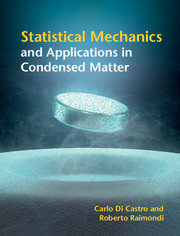Book contents
- Frontmatter
- Contents
- Preface
- 1 Thermodynamics: a brief overview
- 2 Kinetics
- 3 From Boltzmann to Boltzmann–Gibbs
- 4 More ensembles
- 5 The thermodynamic limit and its thermodynamic stability
- 6 Density matrix and quantum statistical mechanics
- 7 The quantum gases
- 8 Mean-field theories and critical phenomena
- 9 Second quantization and the Hartree–Fock approximation
- 10 Linear response and the fluctuation–dissipation theorem in quantum systems: equilibrium and small deviations
- 11 Brownian motion and transport in disordered systems
- 12 Fermi liquids
- 13 The Landau theory of second order phase transitions
- 14 The Landau–Wilson model for critical phenomena
- 15 Superfluidity and superconductivity
- 16 Scaling theory
- 17 The renormalization group approach
- 18 Thermal Green functions
- 19 The microscopic foundations of Fermi liquids
- 20 The Luttinger liquid
- 21 Quantum interference effects in disordered electron systems
- Appendix A The central limit theorem
- Appendix B Some useful properties of the Euler Gamma function
- Appendix C Proof of the second theorem of Yang and Lee
- Appendix D The most probable distribution for the quantum gases
- Appendix E Fermi–Dirac and Bose–Einstein integrals
- Appendix F The Fermi gas in a uniform magnetic field: Landau diamagnetism
- Appendix G Ising and gas-lattice models
- Appendix H Sum over discrete Matsubara frequencies
- Appendix I Two-fluid hydrodynamics: a few hints
- Appendix J The Cooper problem in the theory of superconductivity
- Appendix K Superconductive fluctuation phenomena
- Appendix L Diagrammatic aspects of the exact solution of the Tomonaga–Luttinger model
- Appendix M Details on the theory of the disordered Fermi liquid
- Appendix N Answers to problems
- References
- Index
1 - Thermodynamics: a brief overview
Published online by Cambridge University Press: 05 September 2015
- Frontmatter
- Contents
- Preface
- 1 Thermodynamics: a brief overview
- 2 Kinetics
- 3 From Boltzmann to Boltzmann–Gibbs
- 4 More ensembles
- 5 The thermodynamic limit and its thermodynamic stability
- 6 Density matrix and quantum statistical mechanics
- 7 The quantum gases
- 8 Mean-field theories and critical phenomena
- 9 Second quantization and the Hartree–Fock approximation
- 10 Linear response and the fluctuation–dissipation theorem in quantum systems: equilibrium and small deviations
- 11 Brownian motion and transport in disordered systems
- 12 Fermi liquids
- 13 The Landau theory of second order phase transitions
- 14 The Landau–Wilson model for critical phenomena
- 15 Superfluidity and superconductivity
- 16 Scaling theory
- 17 The renormalization group approach
- 18 Thermal Green functions
- 19 The microscopic foundations of Fermi liquids
- 20 The Luttinger liquid
- 21 Quantum interference effects in disordered electron systems
- Appendix A The central limit theorem
- Appendix B Some useful properties of the Euler Gamma function
- Appendix C Proof of the second theorem of Yang and Lee
- Appendix D The most probable distribution for the quantum gases
- Appendix E Fermi–Dirac and Bose–Einstein integrals
- Appendix F The Fermi gas in a uniform magnetic field: Landau diamagnetism
- Appendix G Ising and gas-lattice models
- Appendix H Sum over discrete Matsubara frequencies
- Appendix I Two-fluid hydrodynamics: a few hints
- Appendix J The Cooper problem in the theory of superconductivity
- Appendix K Superconductive fluctuation phenomena
- Appendix L Diagrammatic aspects of the exact solution of the Tomonaga–Luttinger model
- Appendix M Details on the theory of the disordered Fermi liquid
- Appendix N Answers to problems
- References
- Index
Summary
Thermodynamics is a phenomenological theory based on empirical observations. The thermodynamic laws are a coherent account of the experimental analysis and provide a universally valid description of the behavior of macroscopic systems without referring to their detailed structure. In this chapter we introduce thermodynamics as a prerequisite scenario for statistical mechanics and we do not give an extended exposition of the theory, but only recall the basic concepts as an introduction to the statistical approach.
Equilibrium states and the empirical temperature
A thermodynamic system is any portion of matter, solid, liquid, mixtures, …, which can be described in terms of a small number of parameters, the macroscopic thermodynamic variables, as for example the pressure P and the volume V for a fluid or the magnetic moment and the magnetic field for a paramagnet. These variables are called extensive or intensive, depending whether their value does or does not depend on the amount of matter present in the system. Energy, volume and magnetization are extensive variables, whereas pressure, temperature and magnetic field are intensive.
Thermodynamics deals with macroscopic properties of macro-systems at equilibrium. A thermodynamic equilibrium state must then be characterized as a macroscopic phenomenon defined via macroscopic variables. A system is in equilibrium if the values of the observables we take into consideration and of the parameters describing its state do not change with time. The thermodynamic equilibrium is never fully static. The characterization of a thermodynamic state depends on the observation time, usually at least of the order of fractions of a second, which in any case must always be much longer than any characteristic time scale of the molecular motion (∼10−11 s).
We use a simple example of common experience to illustrate this point. Soon after hot water is poured into a container, it appears to be at rest. If we ask whether the water is in a state of equilibrium, the answer depends obviously on the observation time and on the sensitivity of the measurement. Within the interval of time of a few seconds we do not feel changes in the temperature and in the volume of the water, which during this observation time can be considered at equilibrium by itself.
- Type
- Chapter
- Information
- Publisher: Cambridge University PressPrint publication year: 2015



